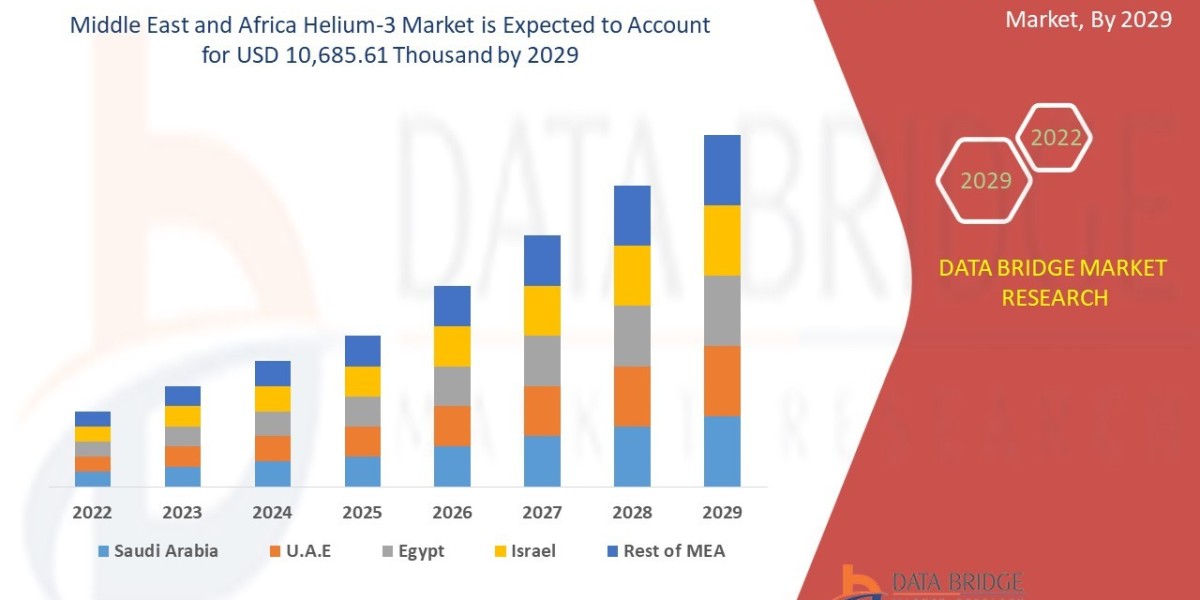Introduction
The Middle East and Africa helium-3 market represents an emerging frontier in the global rare gas industry. Helium-3, a non-radioactive isotope of helium, is prized for its unique physical properties, making it a crucial element in advanced scientific research, cryogenics, nuclear fusion, and national security applications. With growing interest in sustainable energy and the advancement of quantum technologies, helium-3 is increasingly being recognized as a strategic material of the future.
Globally, helium-3 has traditionally been scarce, with supply dependent on limited extraction from nuclear facilities and the decay of tritium. However, the Middle East and Africa are now positioned to play an important role in shaping the future of this market due to their expanding research infrastructure, energy ambitions, and investment in advanced technologies.
This report explores the dynamics of the Middle East and Africa helium-3 market, covering its current landscape, growth drivers, challenges, segmentation, competition, and future outlook. It also highlights opportunities for investors, governments, and businesses to leverage this high-value resource.
Source - https://www.databridgemarketresearch.com/reports/middle-east-and-africa-helium-3-market
Market Overview
The helium-3 market is defined by the production, processing, and utilization of helium-3 gas for applications across research, healthcare, energy, and defense. Unlike helium-4, which is commonly used in balloons and cooling systems, helium-3 is much rarer and is valued for its ability to absorb neutrons, making it a vital component in nuclear detection, cryogenic cooling, and experimental fusion reactors.
Historically, global supply of helium-3 has been extremely constrained, primarily sourced from tritium decay in nuclear stockpiles. However, growing demand from sectors such as medical imaging, national security, and clean energy has intensified research into new supply avenues. While extraction from natural gas remains limited, exploration of extraterrestrial sources such as lunar regolith has also been proposed as a long-term solution.
In the Middle East and Africa, the helium-3 market is still at a nascent stage but is gaining traction. Countries in the Gulf are investing in nuclear research and advanced energy programs, while Africa’s emerging technology hubs and partnerships with international research agencies are opening new avenues for adoption. With expanding research institutions and the global race toward fusion energy, this region holds potential to become an important participant in the helium-3 supply chain.
Market Drivers and Opportunities
Several factors are fueling the growth of the helium-3 market in the Middle East and Africa.
A primary driver is the global pursuit of clean and sustainable energy. Helium-3 is a potential fuel for nuclear fusion, a process that could revolutionize energy production by providing abundant power without harmful radioactive waste. With Gulf nations such as the United Arab Emirates and Saudi Arabia pushing ambitious energy diversification agendas, investment in helium-3 research aligns with their long-term strategies.
Another major driver is the advancement of cryogenics and quantum technologies. Helium-3 plays a critical role in cooling superconducting magnets and quantum computers. As Middle Eastern countries invest in becoming technology and innovation hubs, demand for helium-3 in scientific and industrial research is expected to expand.
Healthcare also offers opportunities. Helium-3 is being explored for its applications in lung imaging and other advanced medical diagnostics. With Africa’s growing healthcare infrastructure and rising investment in advanced diagnostic tools, this segment is poised for steady demand.
Additionally, security and defense applications represent a strategic growth area. Helium-3’s ability to detect neutrons makes it valuable in nuclear monitoring and homeland security systems. Countries in the Middle East, with significant geopolitical interests, are likely to invest in helium-3-based detection technologies.
Finally, international collaborations between Middle East and African nations with global research institutions present opportunities for technology transfer, funding, and skill development.
Market Challenges and Restraints
Despite its potential, the helium-3 market faces significant challenges in the Middle East and Africa.
The most pressing issue is limited supply. Helium-3 remains one of the rarest isotopes on Earth, with production dependent on nuclear reactors and tritium decay. This scarcity drives high costs, making widespread adoption difficult in price-sensitive markets.
Regulatory and policy challenges also restrict market growth. As helium-3 has applications in sensitive areas like nuclear research and defense, its trade and distribution are subject to strict government oversight. In regions where nuclear regulation is still evolving, this creates bottlenecks for companies looking to enter the market.
Infrastructure limitations in Africa pose another hurdle. Many countries lack advanced cryogenic facilities, nuclear research capabilities, or the specialized equipment needed to harness helium-3. Without significant investment in infrastructure and skills, the adoption of helium-3 technologies may remain concentrated in only a few countries.
Furthermore, competition from alternative technologies cannot be overlooked. Advances in other cooling materials, medical imaging methods, and nuclear detection technologies could reduce dependency on helium-3 in certain applications.
Finally, the high cost of research and development presents a barrier, particularly in emerging economies where budgets are constrained. This could slow down the pace of innovation and commercialization in the region.
Market Segmentation Analysis
The Middle East and Africa helium-3 market can be segmented based on product type, application, distribution channel, and regional adoption.
By product type, helium-3 is primarily available in gaseous form, though it may be supplied in specialized containment systems for safe transport and storage. Advanced purification and packaging methods are increasingly important as demand expands into medical and quantum applications.
By application, nuclear research and energy represent the largest potential segment, driven by interest in helium-3 as a fuel for future fusion reactors. Security and defense applications follow, with neutron detection systems already gaining traction. Healthcare is an emerging segment, with lung imaging and other diagnostic technologies offering new opportunities. Cryogenics and quantum computing also stand out as high-potential application areas.
In terms of distribution, direct government procurement and institutional supply dominate due to the sensitive nature of helium-3. Research agencies, defense organizations, and specialized hospitals are the primary consumers. However, private sector involvement is expected to grow as technology commercialization increases.
Regionally, the Gulf states are at the forefront of helium-3 adoption, driven by strong investments in nuclear energy, technology, and research institutions. Africa is still at an early stage, with adoption centered around countries with stronger research infrastructure, such as South Africa. Over time, broader adoption across both regions is expected as infrastructure and partnerships expand.
Competitive Landscape
The competitive landscape of the helium-3 market in the Middle East and Africa is shaped by a small group of specialized players, government agencies, and international collaborators. Due to the rarity and strategic importance of helium-3, supply chains are tightly controlled, and competition is largely centered around research partnerships, technology development, and government contracts.
Global players with expertise in rare gases and nuclear research are increasingly forming alliances with Middle Eastern governments to develop local capacities. Partnerships with universities and research institutions are common, allowing technology transfer and skill development in cryogenics and advanced materials.
Regional players are focusing on building niche expertise in areas such as cryogenics, quantum technology, and medical imaging. Government-backed research initiatives are also playing a pivotal role in strengthening the competitive position of local stakeholders.
Strategies among key players include investing in R&D to explore alternative helium-3 production methods, developing cost-efficient neutron detection systems, and establishing long-term supply agreements with governments and defense organizations.
Future Outlook and Trends
The Middle East and Africa helium-3 market is expected to expand gradually over the next decade, supported by investments in energy, research, and technology infrastructure. While current supply constraints limit widespread adoption, advances in tritium extraction and alternative sourcing methods may ease supply shortages in the future.
One of the most significant trends shaping the market is the pursuit of nuclear fusion. As global projects make progress, helium-3 could emerge as a critical fuel, driving demand across the region. Countries in the Gulf with strong energy diversification agendas are well-positioned to capitalize on this opportunity.
The healthcare segment is also expected to grow, with helium-3 gaining traction in advanced imaging applications. As healthcare systems in Africa modernize, the adoption of such technologies may accelerate.
Quantum technology and cryogenics will further shape the future of the market. With increasing global investment in quantum computing, demand for helium-3 as a cooling medium is likely to rise, providing opportunities for Middle Eastern and African research hubs.
Overall, the market’s future will depend on sustained government support, international collaboration, and technological breakthroughs that make helium-3 more accessible and cost-effective.
Conclusion
The Middle East and Africa helium-3 market is emerging as a promising sector within the global rare gas industry. With applications spanning nuclear energy, cryogenics, healthcare, and security, helium-3 represents both a strategic resource and a driver of future innovation.
Although challenges such as supply scarcity, regulatory restrictions, and infrastructure gaps persist, the region’s growing investment in research and advanced technologies positions it for long-term growth. Stakeholders who invest early in innovation, sustainability, and international collaboration will be well-positioned to capture opportunities in this high-value market.
Looking ahead, helium-3 could play a transformative role in shaping the future of energy, healthcare, and quantum technology in the Middle East and Africa.
Frequently Asked Questions
What is the current size of the Middle East and Africa helium-3 market?
The market is still at a nascent stage, with limited production and adoption. However, growing investment in nuclear research, healthcare, and quantum technologies is expected to expand its size significantly in the coming years.
What are the key drivers influencing growth in this market?
Key drivers include the pursuit of clean nuclear fusion energy, rising demand for cryogenics and quantum computing, healthcare imaging applications, and security needs for neutron detection.
Which regions dominate the Middle East and Africa helium-3 market?
The Gulf states, including the United Arab Emirates and Saudi Arabia, are at the forefront due to their investments in nuclear energy and technology. South Africa is also a notable player in Africa with its advanced research capabilities.
Who are the major players in the industry?
The market includes a mix of global rare gas suppliers, government-backed research institutions, and regional players focusing on cryogenics, quantum technology, and medical imaging. Partnerships and collaborations play a key role in this sector.
What are the latest trends shaping the future of this market?
Emerging trends include the use of helium-3 in nuclear fusion research, expansion of quantum computing applications, advancements in medical imaging, and efforts to develop alternative sourcing methods.
What challenges could slow down growth in this sector?
Challenges include the scarcity of helium-3, high production costs, regulatory restrictions, limited infrastructure in some regions, and competition from alternative technologies.
How can businesses benefit from investing in the helium-3 market?
Businesses can benefit by focusing on niche applications such as medical imaging, neutron detection, and cryogenics. Investing in R&D, forming strategic partnerships, and aligning with government initiatives are key strategies for success.
Browse More Reports:
Global Urticaria Market
Global UV Adhesive Market
Global Varicose Vein Treatment Market
Global Veneer Sheets Market
Global Windows and Doors Market
Europe Alcoholic Beverages Market
Asia-Pacific Alopecia Treatment (Hair Loss) Market
Middle East and Africa Alopecia Treatment (Hair Loss) Market
Thailand Business Process Outsourcing (BPO) Market
Europe Corrugated Board Packaging Market
Asia-Pacific Essential Oils Market
U.S. Fleet Management Market
North America Fleet Management Market
Middle East and Africa Helium-3 Market
Europe Hemodialysis and Peritoneal Dialysis Market
Europe Industrial Metrology Market
Middle East and Africa Industrial Metrology Market
Europe Insect Protein Market
Asia-Pacific Insect Protein Market
Middle East and Africa Insect Protein Market
About Data Bridge Market Research:
An absolute way to forecast what the future holds is to comprehend the trend today!
Data Bridge Market Research set forth itself as an unconventional and neoteric market research and consulting firm with an unparalleled level of resilience and integrated approaches. We are determined to unearth the best market opportunities and foster efficient information for your business to thrive in the market. Data Bridge endeavors to provide appropriate solutions to the complex business challenges and initiates an effortless decision-making process. Data Bridge is an aftermath of sheer wisdom and experience which was formulated and framed in the year 2015 in Pune.
Contact Us:
Data Bridge Market Research
US: +1 614 591 3140
UK: +44 845 154 9652
APAC : +653 1251 975
Email:- corporatesales@databridgemarketresearch.com









